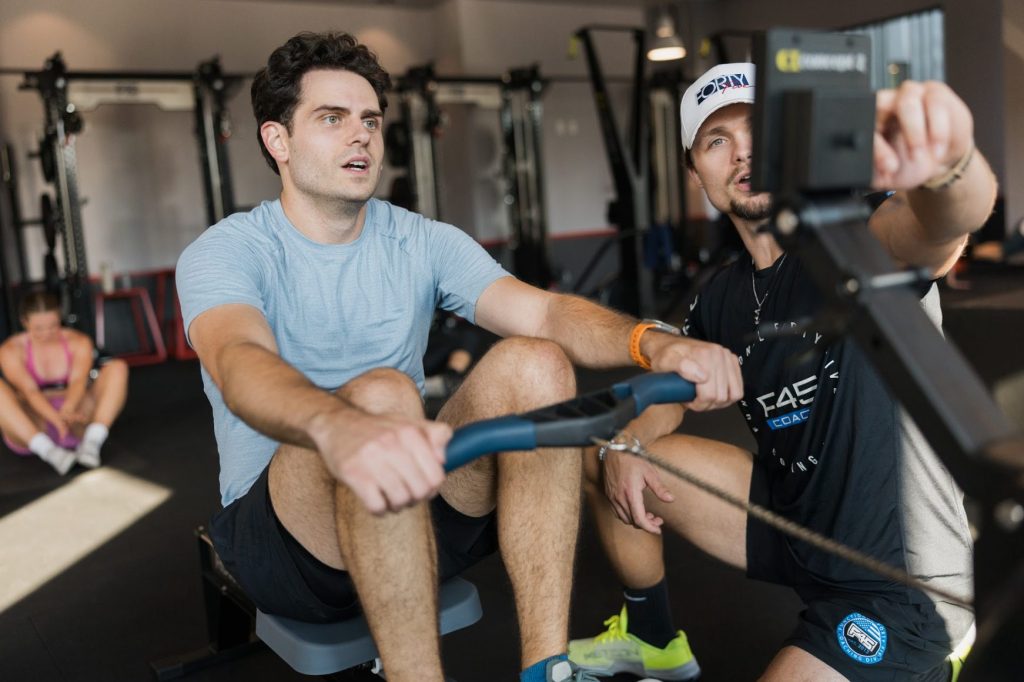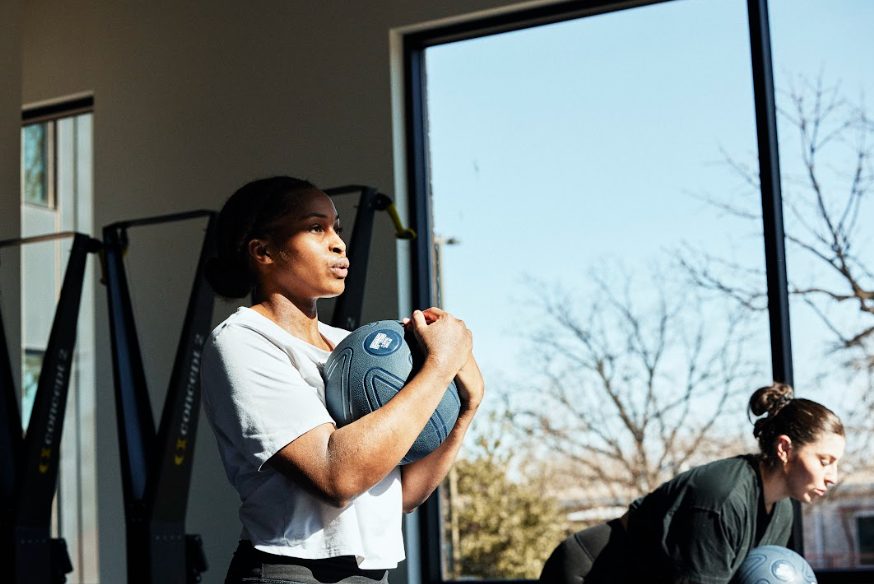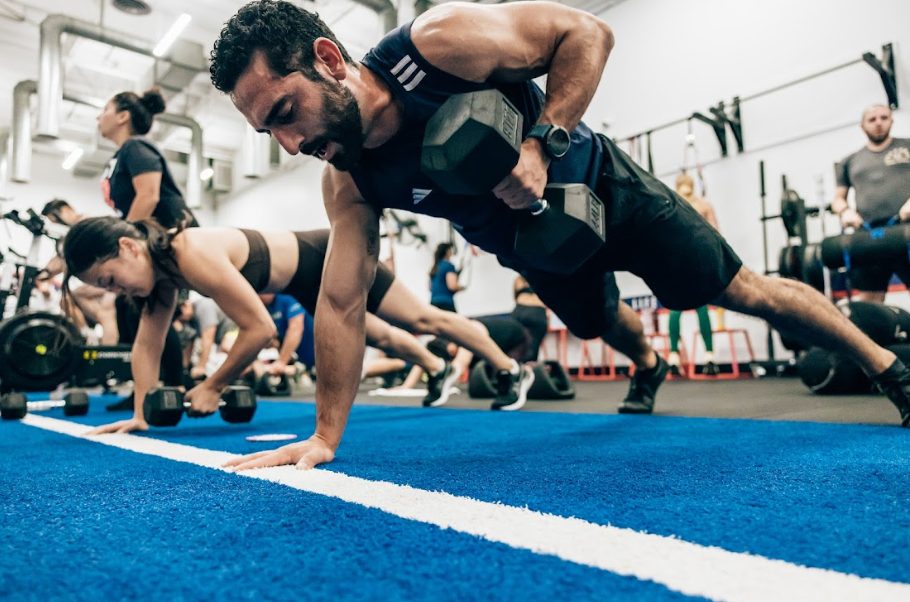Whenever you push yourself in cardio workouts, your body will adapt to become more efficient and powerful. It can feel even more empowering when you know the best way to measure your results and the changes that are occurring in your body.
To this end, understanding your VO2 max is a great place to start.
But what is a good VO2 max? And what exercises can you do to get there? The trainers at F45 deliver a variety of workouts built with aerobic, strength and HIIT exercises to take your VO2 max to the next level. Below, we’ll be exploring what VO2 max means and how to improve your VO2 max.

What does VO2 max mean?
The abbreviation ‘VO2 max’ stands for the following:
- V refers to volume
- O2 refers to oxygen
- Max refers to maximum
Your VO2 max measures the maximum amount of oxygen your body can utilise per kilogram of body weight, per minute. It’s known as the best indicator of your cardio or aerobic capacity; and the higher your VO2 max is, the more athletic you will generally feel and be.
What does VO2 max measure?
To understand your VO2 max, you first need to know how your cardiorespiratory system works. During cardio or HIIT workouts, your muscles require oxygen to function. You breathe in oxygen, which then travels through to your lungs and enters your bloodstream. Your oxygenated blood is then pumped from your heart to your muscles and the rest of your body.
To be more specific, your VO2 max measures the amount of oxygen you’re able to transport from the outside air, through your internal organs and then into your muscles – per kilogram of body weight per minute.
VO2 max and weight loss
One area that causes some confusion when F45 trainers are asked “what does VO2 max measure?” is its relationship with body weight. With the way VO2 max is currently measured (oxygen utilised per kilogram of body weight per minute), the lighter you are, the higher your VO2 max is. In other words, losing weight is one way to improve your VO2 max.
However, this also means that if you gain muscle (increasing your weight), you may decrease your VO2 max. Similarly, people who have naturally bigger bodies will have a lower VO2 max than a smaller person with the same fitness level. Because of this, if you also want to build muscle with resistance workouts, it may me more useful to measure your VO2 max in relation to your lean muscle mass, rather than your entire body weight, as your lean muscle is what utilises oxygen.¹
What is a good VO2 max by age?
A healthy VO2 max can be influenced by a variety of factors, such as your age, sex, genetics, and the altitude you’re exercising in. When learning how to improve your VO2 max, it’s useful to have a frame of reference for what a good VO2 max is that you can aspire to. Below are some common ranges.
Good VO2 maxes by age:
Below 29 years: 39 to 53mL/kg/min
30-39 years: 37 to 50mL/kg/min
40-49 years: 35 to 45mL/kg/min
50-59 years: 34 to 43mL/kg/min
60-69 years: 33 to 41mL/kg/min
70+ years: 28+ mL/kg/min
How to improve your VO2 max?
To improve your VO2 max, you’ll need to strengthen your heart and muscles, so oxygen can be transported and received more efficiently. To achieve this, there’s a range of functional workouts you can do to challenge yourself.
We suggest training with a variety of workout intensities and exercises, as VO2 max is measured per minute, so you’ll need both the capacity to perform at a high intensity and to sustain it.
Let’s explore some of the types of exercise you can do below.
HIIT training
When learning how to improve your VO2 max, high intensity interval training is the most specific training you can do to increase it.2 This is because HIIT training involves constantly performing near your maximum heart rate, which is the level that’s required to measure your VO2 max.
A simple yet useful interval exercise to improve your VO2 is to run as fast as you can for four minutes, and then rest for 3 minutes, repeating this four times. If you want to enjoy the benefits of HIIT and cardio training, jog during the rest period rather than walk. As with any HIIT workout, this should only be carried out after a warmup.
Endurance training
Building a strong aerobic base is fundamental to increasing your VO2 max.3 If you’re unsure how to improve endurance running, some common milestones for distance running are to run a 2.4km, 5km and then 10km, slowly building up as your body adapts. Developing your endurance will help you feel more comfortable performing at around 60-70% of your heart rate, making it easier for you to dip in and out of that 80-90% zone that you enter with HIIT training.
Light cardio
Achieving what’s considered a good VO2 max by your age doesn’t have to involve rigorous training. If you’re an older person, new to fitness, or returning to exercise after some time away, you can quickly increase your VO2 max with a variety of light aerobic exercises instead. With light cardio movement you still receive the benefits of aerobic exercise, but won’t need to go over 65% of your maximum heart rate.
Some common light aerobic exercises are:
- Brisk walking
- Jogging
- Cycling
- Swimming
How long does it take to increase your VO2 max?
The rate at which your VO2 max increases will be different for everyone. It depends on your current level of fitness, and the frequency and intensity of your training. You can also support your results with quality recovery workouts and nutrition. As with all fitness, the law of diminishing returns applies to learning how to improve your VO2 max.
In general, if you’re new to VO2 max training, you may experience strong improvements in four to six weeks. Whereas if you’re already very fit, you will slowly increase your VO2 max over multiple months.
Increasing your VO2 max can be a solo or collective venture. If you want the expert knowledge and encouragement of the F45 community behind you, explore how group fitness classes work.
1 https://www.ncbi.nlm.nih.gov/pmc/articles/PMC7504314/
2 https://pubmed.ncbi.nlm.nih.gov/17414804/
3 https://pubmed.ncbi.nlm.nih.gov/26243014/














